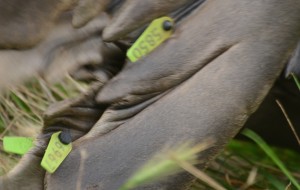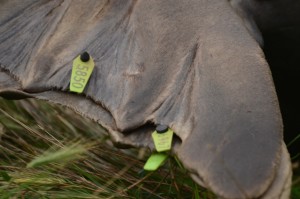It is a beautiful evening with God rays and backlit clouds after light westerly winds and rain showers for most of the day. The afternoon swell told of offshore storms but the wind waves here were fairly calm throughout the day. The barometer continued yesterday’s slide in the morning but climbed out its bowl after lunch and is still climbing as the sun sets over behind Neah Bay. Tomorrow looks finer but strong wind warnings continue and it looks like it will turn to another southeaster by evening.

The sun was setting north of the Straits of Juan de Fuca when I arrived at the end of August. Now it sets in behind Neah Bay
In spite of wet, cool weather, the whale watching boats continue to ply their trade and a total of four boats were noted in the Ecological Reserve today. There are also hardy sports-fishers, still looking for the big one. Most of those boats steer around the Ecological Reserve and a minority of those who pass through, still do not heed the Ecological Reserve speed limit of 7 knots.
More on the tagged Elephant Seal spotted last Sunday. I thought that I had found another tagged animal yesterday because even though I was fairly sure it was the same animal #6967, the tag I spotted was #5850. I finally managed to get a photo showing both tags.

Mark re-capture or re-sight data is used to estimate population numbers and tendencies. These two tags tell of an interesting story about assumptions and how we need to be careful of our assumptions as they can hide the truth.
Patrick Robinson, Director of Ano Nuevo Reserve, explained that they are double-tagging Northern Elephant Seal weaners with non-matching numbers and it was interesting to learn why. Mark-racapture is a technique long used by biologists to determine population sizes and is based on known proportions, the number of individuals marked versus the total number counted. The students at Pearson College use this technique to estimate limpet populations. Mark re-sight is similar and, you guessed it, recapture is not necessary, just re-sighting. Adult bull Northern Elephant Seals can weigh up to 2,000 kilos, be 4 meters long and are known to be aggressive so I am really relieved that recapture is not needed to do the math. What is messing up the math is the assumption the animals that have lost their tags are dead and of course it is much more complex than that even if they have two tags.
Researcher Lisa Schwarz, of Dan Costa’s lab at the University of California Santa Cruz, is experienced modelling demographics in other species of marine mammal, including the Southern Elephant Seal. She is now looking at problematic assumptions about tag loss that can reduce perceived survival rates in Norther Elephant Seals. In Southern Elephant Seals, her team found that the “assumption of independent tag loss produced an underestimate in the proportion of animals with zero tags which led to underestimates in survival.” It turns out for many species that they are more likely to lose both tags than just one. They also found that tag loss varies with age, sex and health. Her work on Northern Elephant Seals will further refine the demographics modelling for this species. That is the backstory of the tale of two tags which is of course really just the tip of the iceberg. If you want to read more here is a link to Lisa’s paper on Southern Elephant Seals. http://www.esajournals.org/doi/pdf/10.1890/ES12-00132.1

Lisa Schwartz is interested to see if Northern Elephant Seals’ tag loss patterns are similar to their southern ‘cousins’. The results may have implications for predicting accurate survival rates in young animals, adult males and females.
Maintenance chores were mostly of the indoor variety today after getting pretty soaked doing a quick town run in the boat. I have improved my landing technique and tie two lines crossed in front of the bow while winching the boat aboard the cradle. It seems to reduce the stern movement a little. The swell was also more manageable today. Picking your weather for boating forays is key to safety at Race Rocks.
